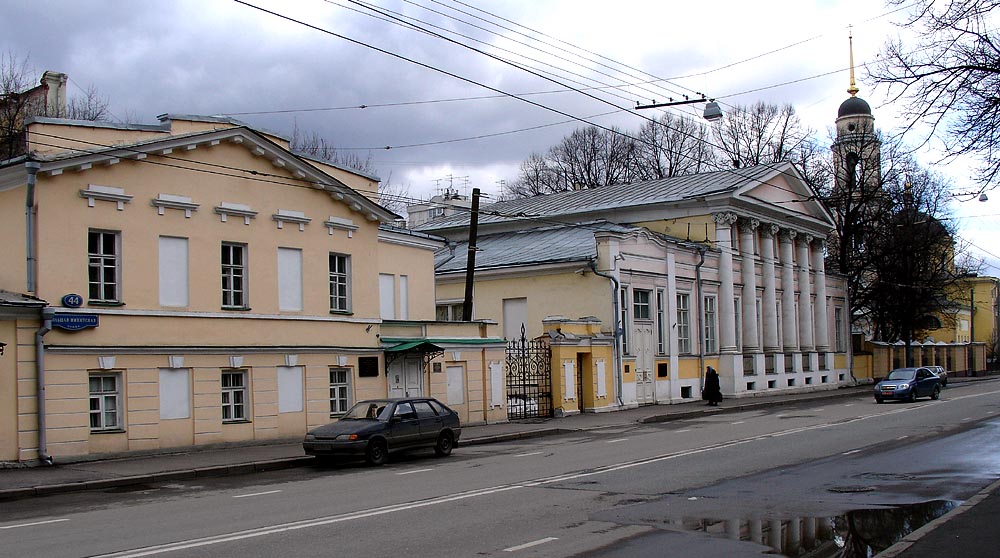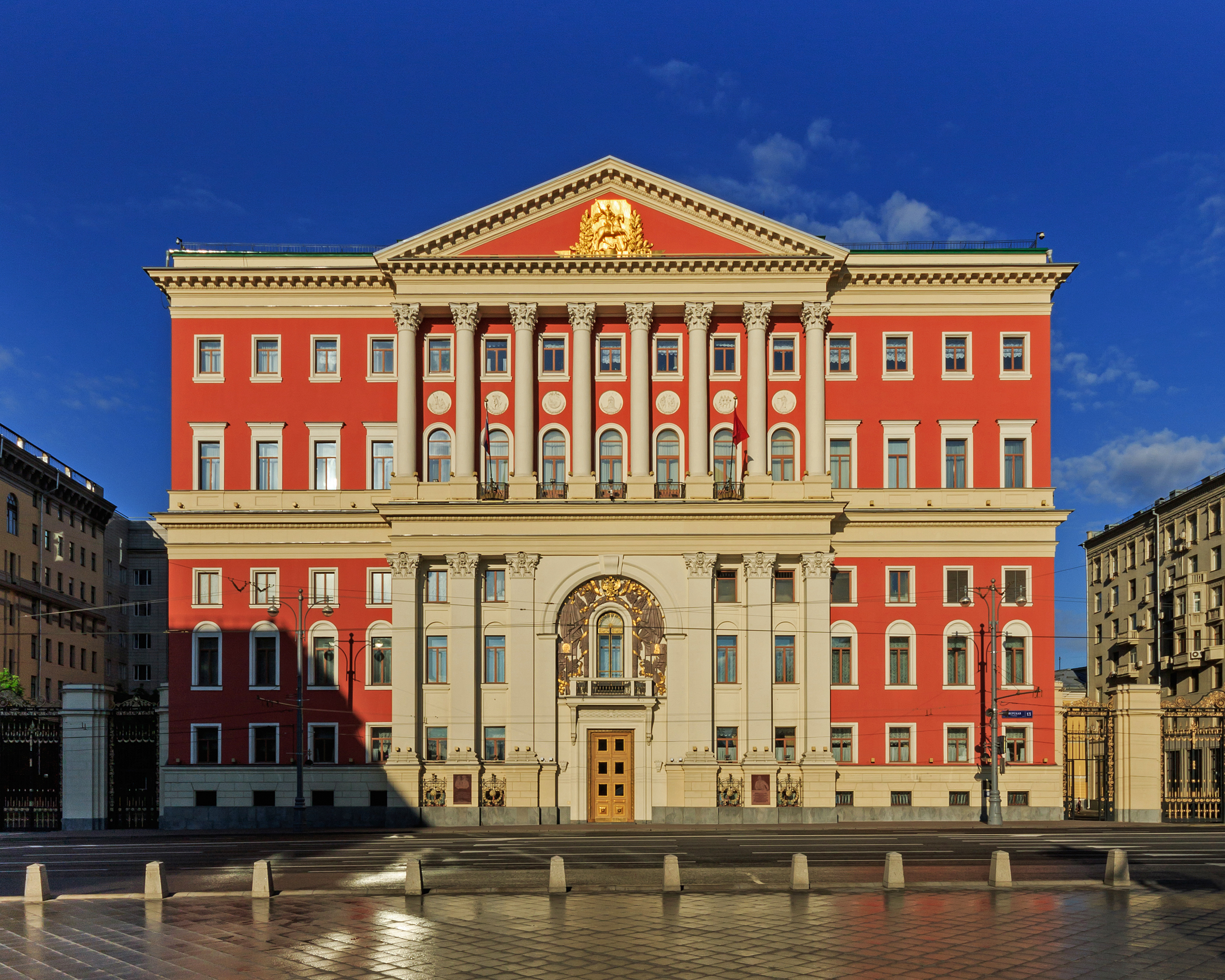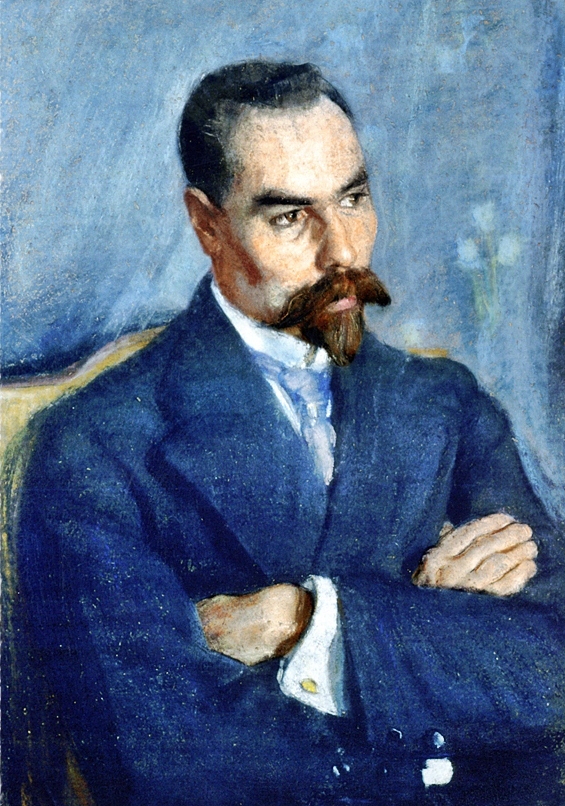|
Voznesensky Lane
Voznesensky Lane (russian: Вознесенский переулок) (first known name - Novgorodsky, and then from the end of the 16th to the end of the 18th century - the Ascension, the end of the 18th century to 1922 - Bolshoy Chernyshyovsky, 1922-1993 - Stankevich, 1994 on, once again Voznesensky) is a lane in Arbat District, Arbat and Presnensky District, Prenya Administrative division of Moscow, districts of the Central Administrative District of the Federal cities of Russia, Federal City of Moscow. Voznesensky Lane passes from Bolshaya Nikitskaya Street Tverskaya Street between Leontevsky Lane and Bryusov Lane. Numbering of houses begins from Bolshaya Nikitskaya Street. History Wooden Church of the Assumption in this place known since the beginning of the 16th century, stone built in 1584, the Tsar Feodor I of Russia, Feodor I in memory of his coronation, and since then two centuries called Voznesensky Pereulok. In 1782 he was appointed governor of the Moscow Count Zakhar ... [...More Info...] [...Related Items...] OR: [Wikipedia] [Google] [Baidu] |
Moscow
Moscow ( , US chiefly ; rus, links=no, Москва, r=Moskva, p=mɐskˈva, a=Москва.ogg) is the capital and largest city of Russia. The city stands on the Moskva River in Central Russia, with a population estimated at 13.0 million residents within the city limits, over 17 million residents in the urban area, and over 21.5 million residents in the metropolitan area. The city covers an area of , while the urban area covers , and the metropolitan area covers over . Moscow is among the world's largest cities; being the most populous city entirely in Europe, the largest urban and metropolitan area in Europe, and the largest city by land area on the European continent. First documented in 1147, Moscow grew to become a prosperous and powerful city that served as the capital of the Grand Duchy that bears its name. When the Grand Duchy of Moscow evolved into the Tsardom of Russia, Moscow remained the political and economic center for most of the Tsardom's history. When th ... [...More Info...] [...Related Items...] OR: [Wikipedia] [Google] [Baidu] |
Bolshaya Nikitskaya Street
Bolshaya Nikitskaya Street (russian: Большая Никитская улица, ''Nikitskaya Ulitsa'') is a radial street that runs west from Mokhovaya Street to Garden Ring in Moscow, between Vozdvizhenka Street (south) and Tverskaya Street (north). Central, eastern part of the street is notable for its educational institutions (old Moscow State University and Moscow Conservatory) and theaters, western part beyond the Boulevard Ring has many Neoclassical mansions and competes with nearby Povarskaya Street for the title of Moscow's Embassy Row. History The street originated in the Middle Ages as a thoroughfare leading to Volokolamsk and Novgorod and was known as ''Volotskaya Street'' (eastern half) and ''Novgorodskaya Street'' (western half); a colony of Novgorod traders existed in present-day Bryusov Lane till the 18th century. In the 16th century, Ivan IV of Russia established his Oprichnina Court on site of present-day University buildings. ''Nikitskaya'' name goes back t ... [...More Info...] [...Related Items...] OR: [Wikipedia] [Google] [Baidu] |
Mossovet
The Mossoviet (Russian: Моссовет), an abbreviation of Moscow Soviet, (Московский Совет) was established following the February Revolution . Initially it was a parallel, shadow city administration of Moscow, Russia run by left-wing parties. Following the October Revolution it became the city administration of Moscow throughout the Soviet period (1918–1991). Initial period The first meeting of the Moscow Soviet of Workers’ Deputies occurred on 1 March, 1917. The meeting was initially attended by 52 delegates from various factories, cooperative societies and trade unions. However when the meeting was reconvened in the evening after a short adjournment, the meeting had swollen to over six hundred delegates. An executive committee of 44 members was created under the leadership of Lev Khinchuk a member of the Menshevik faction of the Russian Social Democratic Labour Party. After the Bolshevik seizure of power Between 1918 and 1941, these two administrations ... [...More Info...] [...Related Items...] OR: [Wikipedia] [Google] [Baidu] |
Tver
Tver ( rus, Тверь, p=tvʲerʲ) is a city and the administrative centre of Tver Oblast, Russia. It is northwest of Moscow. Population: Tver was formerly the capital of a powerful medieval state and a model provincial town in the Russian Empire, with a population of 60,000 on 14 January 1913. It is situated at the confluence of the Volga and Tvertsa Rivers. The city was known as Kalinin ( rus, Кали́нин, Kalínin) from 1931 to 1990. The city is where three rivers meet, splitting the town into northern and southern parts by the Volga River, and divided again into quarters by the Tvertsa River, which splits the left (northern) bank into east and west halves, and the Tmaka River which does the same along the southern bank. History Medieval origins Tver's foundation year is officially accepted to be 1135,Charter of Tver, Article 1 although there is no universal agreement on this date and some estimates place it as late as the second half of the 13th century. The ... [...More Info...] [...Related Items...] OR: [Wikipedia] [Google] [Baidu] |
Zakhar Chernyshyov
Zakhar Grigoryevich Chernyshev (172231 August 1784) was a Russian noble, courtier to Catherine the Great, Imperial Russian Army officer, and Imperial Russian politician in the 18th century. After made a courtier to then-Princess Sophie of Anhalt-Zerbst in 1744, Chernyshev remained a favorite of the future Russian monarch into the 1770s. An Imperial Russian Army officer during the Seven Years' War, Chernyshev retired in 1764, and would be ultimately promoted to General Field Marshal by Catherine II. At her appointment, Chernyshev led the College of War from 1764–1774, served as her governor-general of the Pskov and Mogilev Governorates, and was the mayor of Moscow until his death. Personal life Born a Russian count in 1722, Zakhar Grigoryevich Chernyshev (russian: text=Захаръ Григорьевичь Чернышевъ) was the older brother of Ivan and Andrei Chernyshev. By 1744, Chernyshev spoke Russian, French, and German. When Princess Sophie of Anhalt-Zerbst w ... [...More Info...] [...Related Items...] OR: [Wikipedia] [Google] [Baidu] |
Coronation
A coronation is the act of placement or bestowal of a coronation crown, crown upon a monarch's head. The term also generally refers not only to the physical crowning but to the whole ceremony wherein the act of crowning occurs, along with the presentation of other items of regalia, marking the formal investiture of a monarch with regal power. Aside from the crowning, a coronation ceremony may comprise many other rituals such as the taking of special vows by the monarch, the investing and presentation of regalia to the monarch, and acts of homage by the new ruler's subjects and the performance of other ritual deeds of special significance to the particular nation. Western-style coronations have often included anointing the monarch with holy anointing oil, holy oil, or chrism as it is often called; the anointing ritual's religious significance follows examples found in the Bible. The monarch's consort may also be crowned, either simultaneously with the monarch or as a separate eve ... [...More Info...] [...Related Items...] OR: [Wikipedia] [Google] [Baidu] |
Feodor I Of Russia
Fyodor I Ivanovich (russian: Фёдор I Иванович) or Feodor I Ioannovich (russian: Феодор I Иоаннович; 31 May 1557 – 17 January (NS) 1598), also known as Feodor the Bellringer (russian: Феодор Звонарь), reigned as Tsar of Russia from 1584 until his death in 1598. Feodor's mother died when he was three, and he grew up in the shadow of his father, Ivan the Terrible. A pious man of retiring disposition, Feodor took little interest in politics, and the country was effectively administered in his name by Boris Godunov, the brother of his beloved wife Irina. His childless death marked the end of the Rurik dynasty, and spurred Russia's descent into the catastrophic Time of Troubles. In Russian documents, Feodor is sometimes called ''blessed'' (russian: Блаженный). He is also listed in the "Great Synaxaristes" of the Orthodox Church, with his feast day on January 7 (OS). Background Feodor was born in Moscow, the son of Ivan IV (T ... [...More Info...] [...Related Items...] OR: [Wikipedia] [Google] [Baidu] |
Bryusov Lane
Valery Yakovlevich Bryusov ( rus, Вале́рий Я́ковлевич Брю́сов, p=vɐˈlʲerʲɪj ˈjakəvlʲɪvʲɪdʑ ˈbrʲusəf, a=Valyeriy Yakovlyevich Bryusov.ru.vorb.oga; – 9 October 1924) was a Russian poet, prose writer, dramatist, translator, critic and historian. He was one of the principal members of the Russian Symbolist movement. Darko Suvin, "Bryusov,Valery" in Curtis C. Smith, '' Twentieth-Century Science-Fiction Writers''. Chicago, St. James, 1986. (pp. 840–41). Background Valery Bryusov was born on 13 December 1873 (1 December 1873 according to the old Julian calendar) into a merchant's family in Moscow. His parents were educated for their class and had some literary associations, but had little do with his upbringing, leaving the boy largely to himself. He spent a great deal of time reading "everything that fell into ishands", including the works of Charles Darwin and Jules Verne, as well as various materialistic and scientific essays. ... [...More Info...] [...Related Items...] OR: [Wikipedia] [Google] [Baidu] |
Tverskaya Street
Tverskaya Street ( rus, Тверская улица, p=tvʲɪrˈskajə ˈulʲɪt͡sə), known between 1935 and 1990 as Gorky Street (russian: улица Горького), is the main radial street in Moscow. The street runs Northwest from the central Manege Square in the direction of Saint Petersburg and terminates at the Garden Ring, giving the name to Tverskoy District. The route continues further as First Tverskaya-Yamskaya Street, Leningradsky Avenue and Leningradskoye Highway. History and architecture Middle Ages to 18th century Tourists are told that Tverskaya Street existed as early as the 12th century. Its importance for the medieval city was immense, as it connected Moscow with its superior, and later chief rival, Tver. At that time, the thoroughfare crossed the Neglinnaya River. The first stone bridge across the Neglinnaya was set up in 1595. In the 17th and 18th centuries, Tverskaya Street was renowned as the centre of Moscow's social life. The nobility co ... [...More Info...] [...Related Items...] OR: [Wikipedia] [Google] [Baidu] |
Federal Cities Of Russia
In the Russia, Russian Federation, a city of federal importance ( rus, город федерального значения, r=gorod federalnogo znacheniya), also known as a federal city, is a types of inhabited localities in Russia, city that has a status of both an inhabited locality and a constituent Federal subjects of Russia, federal subject. There are two federal cities within Russia's internationally recognised territory: Moscow and Saint Petersburg. , Sevastopol, which is internationally recognised as part of Ukraine, is currently occupied by Russian forces and described by the Russian government as Russia's third federal city. Moscow and Saint Petersburg are list of cities and towns in Russia by population, the largest cities in the country: Moscow is the capital city, national capital and Saint Petersburg is a previous Russian capital and important port city in the Baltic Sea. Sevastopol is located in Crimea, which is internationally recognised as part of Ukraine. ... [...More Info...] [...Related Items...] OR: [Wikipedia] [Google] [Baidu] |
Russia
Russia (, , ), or the Russian Federation, is a List of transcontinental countries, transcontinental country spanning Eastern Europe and North Asia, Northern Asia. It is the List of countries and dependencies by area, largest country in the world, with its internationally recognised territory covering , and encompassing one-eighth of Earth's inhabitable landmass. Russia extends across Time in Russia, eleven time zones and shares Borders of Russia, land boundaries with fourteen countries, more than List of countries and territories by land borders, any other country but China. It is the List of countries and dependencies by population, world's ninth-most populous country and List of European countries by population, Europe's most populous country, with a population of 146 million people. The country's capital and List of cities and towns in Russia by population, largest city is Moscow, the List of European cities by population within city limits, largest city entirely within E ... [...More Info...] [...Related Items...] OR: [Wikipedia] [Google] [Baidu] |






